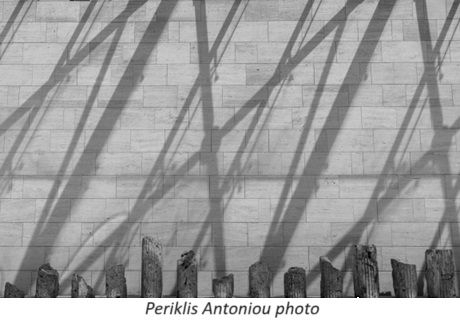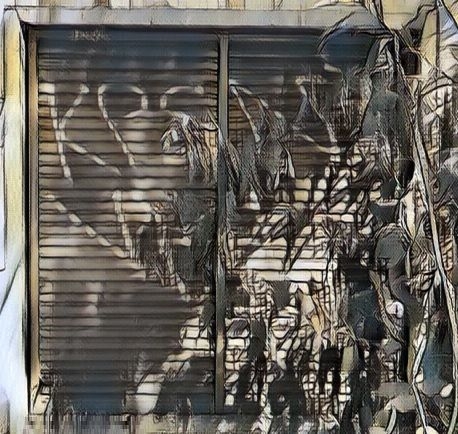I did not recall that I had talked about the uprising against the dictatorship at the Polytechnic University that early. I was reminded by a newspaper clipping from “Rizospastis” newpaper from the second anniversary of the uprising. It comprised of a type of common statements made by myself and Ioanna Karystiani regarding the identity and meaning of the uprising. I found the clipping neatly filed by the National Safety Agency in the relatively “safe” file about me that they turned over to me in 2017, after having performed the process that is referred to as “weeding” in English on the original file before disclosure. In the blurry photograph of the photocopy, was myself and Ioanna looking at the lens, at a heart wrenching young age.
For years, my accounts of the Polytechnic uprising were purely political. The first account with an experiential “ambience” is the short and rather bitter piece entitle “Those were our best years”, in the collective edition edited by Dimitris Papachristos and published on the 20th anniversary under the title “19+1”. However, this article also mainly comprised of estimations. I think that it took me another decade in order to complete this process, and be able to participate in relevant tributes with papers that were of course political, but were basically experiential; they were what in oral history is termed “personal testimonies”. For the past 20 years, this term better fits my papers, interviews, documentary participations, and my attempt at painting a “complete” picture/evaluation of the Polytechnic uprising, in the collective edition edited by Iasonas Chandrinos, entitle “Here for the entire night”.
However, the same idea/opinion is firmly set in the epicentre of my every “testimony”: the realization that as the years go by, the Polytechnic uprising – for me personally – as an image primarily, is not the students that organised it through huge, never before seen, conflictual and unifying processes of immediate democracy. Nor is it the Greek people that quite literally embraced it and supported it by smuggling food, cigarettes, and money to unfamiliar hands through the fence, with the unwavering conviction that they would reach the Coordinating Committee and the kitchen. Nor is the young labourers and workers, boys and girls that started flocking to the centre of Athens on Friday evening, from the blue-collar neighbourhoods of the city, and found themselves clashing with ministry guards, paying no heed to the gunshots fired by snipers, thus giving the uprising an aspect of popular revolt.
What gets repeated, and not by coincidence either, is the “chain” that formed spontaneously, comprising of schoolchildren, with only a handful of university students among them – myself being one of them - near the main gate, amongst the rampage of teargas and flames on the evening of that Friday. All this happened in the courtyard of the Polytechnic that was enclosed by a zone of “sanitary confinement”, that only a few dared to trespass anymore because of the snipers that were perched on the rooftops. This double chain was formed for a single reason: To hasten the crossing of the injured that were carried by the members of the student safeguard from the main gate to the infirmary, by keeping a pathway open in a confined space where at least 4,000 people were swirling around. The same procedure was followed every time: At long intervals, a gunshot was heard, and – it was never a burst of volleys as it was always well aimed. Then a group from the safeguard team would appear with Filippakis - who was put in charge by the Coordinating Committee - at its head. They would unlock the main gate and go running out on the surrounding streets. They were never shot at, and they would return carrying a wounded person. As they passed through the pathway that was kept open by the double chain of young students, their blood was dripping on the ground. For the entire duration that this chain of small children remained with their arms locked - these were children that only a few hours ago had been playing in the Polytechnic’s courtyard as they had previously done in their schoolyard – the were SINGING non-stop.
However, this image, that for me was the most compelling one, did not appear in any other oral testimony. Until at some point, I began questioning whether it really happened – even though I can still see it clear as day when I close my eyes… Then in 2019, someone I did not know, that happened to be one of these students, came forward and described the scene in a publication – and I breathed a sigh of relief…
And later in November 2021, a well known journalist from Heraklion informed me that the pharmacist Hara Troullinou spoke publicly for the first time on a live radio interview on the 48th anniversary of the uprising, describing her own experiences, and among other things made mention of the “chain of Cretan students” that were singing. Hara was an old friend and comrade that I hadn’t seen for quite a few years. Back in the day, she was a Pharmacy student and a member of a 20-person student organisation (of mainly Cretan students) that was controlled by a three-person committee of the Communist Party Youth Organisation, of which I was the Secretary. Hara’s entire account is fascinating but I was glued to her description of the chain:
“… They were dropping the teargas from early on. We were lighting fires and spilling water. Everything had turned into muck. Laliotis was negotiating at the main gate. It was then that Nadia (Valavani) came and told me: “All you Cretan kids will lock arms in front of the small gate that will open momentarily, the one that is next to the main gate. You will form a pathway and safeguard it, and the gurneys with the injured will pass through. No matter what happens, no matter what you see you will continue singing “The Laughing Boy” by Mikis Theodorakis”.
“I remember that we locked arms with Theofilos Troullinos and Fofi Tamiolaki, and began singing. Oh, how I wish that it could have been recorded somehow. You should have heard how some twenty-year-olds were singing, with a voice that was no longer coming out after three days of chanting and singing about all the laughing children whose smile had frozen on their faces. How does one sing with no voice: Bread Education Liberty!!! When will the night sky be clear again[1]!!! The gurneys passed in front of us. I should rather say the caskets. I turned and asked Theofilos ‘Why are their faces covered with sheets?’ We looked at each other. We didn’t speak. For a moment we froze. We doubled down, and continued singing, louder this time. Much later the tank turned on its lights and we realised that it would crash through the gate. We were forcefully pulled back.
It was then that we unlocked our arms with Theofilos. I never saw him again. We lost one another…”
For the past two years, I have been playing back Hara’s words in my mind, but I have not gone to speak with her. I am almost certain now of what had transpired. There must have been two singing chains. I found myself holding on to the chain of young schoolchildren that was formed with no guidance, spontaneously to facilitate the transportation of the injured from the main gate to the infirmary on Friday evening. Hara, like thousands of others, did not see, or does not remember this chain, in a courtyard filled with teargas and the smoke from the fires we lit. Thanks to the experience of the chain of schoolchildren, later that night, when it was necessary to take the wounded outside on makeshift gurneys, going the exact opposite way - from the infirmary to the gate - where the few available ambulances were waiting for them, I must have intervened in order to create a second chain, consisting of those who were more readily available, and it so happened that those were the Cretan students. I say “must have” because I don’t remember any of this – neither the second chain, nor my own intervention…
History must ultimately be recorded chronologically as it happens, as close as possible to the actual events that comprise its starting points. It might be true that in order for conclusions to composedly mature, a certain chronological distance is necessary, but this is not the case for events themselves. My generation was moving forward without looking back, having an unwavering feeling that it was creating the future – as if a future such as the one we dreamed of, without an elementary at the very least settling of our scores with the past, was ever possible. In our statutes we, more or less, implied that such a thing was not necessary when we stated that “we share the best traditions” with the previous generation; as if an inheritance that is so complex can be shared that easily.
The previous generation, that of the Resistance to the Nazis, that quite literally passed through fire and steel, is gone now, leaving behind voids that are almost terrifying, having taken with it an irreplaceable abundance of wealth of experience and memory; the “small history” that only a few people were interested in safekeeping, while those that bore it were still alive. Now that the physical extinction of our generations is also under way, fifty years after the only popular uprising that we were fortunate enough to experience, we should not allow these elements that are a thorn in the eye of the governing elite, to also be irreversibly lost. Who knows? If we succeed in protecting them from their statute of limitations, they may one day be incorporated in the future of children that have not yet been born…
[1]T/N: A traditional Cretan revolutionary song that was initially sung in Cretan revolutions. After Crete was unified with the rest of Greece in 1913, it started being used in connection with many events in the whole of Greece, like World War II, and the Polytechnic uprising.


